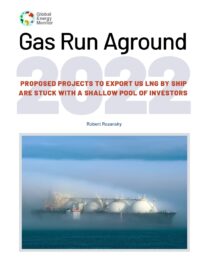
REPORT: Despite high prices, a $244 billion LNG expansion remains stalled due to lack of long-term commitments and financing
SAN FRANCISCO. A new wave of projects to expand the United States’ liquefied natural gas (LNG) export capacity is facing stiff headwinds, according to a survey of 21 proposed LNG terminals by Global Energy Monitor (GEM). New projects are struggling to find financiers and buyers, as projects are set to confront competition from lower-priced international producers, pressure from cheap renewables, and tightening climate commitments.
Key Points
- No proposed US LNG export terminals reached final investment decisions (FIDs) or advanced to the construction phase in 2021.
- New LNG export projects have received few of the purchasing commitments needed to demonstrate to potential financiers and investors that their product will find buyers. Companies have only secured purchasing agreements publicly linked to four new projects, out of 21 total. Of the four projects with offtake contracts, two are still far from demonstrating that a substantial share of production will be anchored with long-term commitments.
- Few institutions are directly financing proposed LNG export terminals. Of the 21 proposed terminals, GEM has identified only three that have received direct project finance. Total project finance identified for these terminals amounts to US$1.6 billion, a drop in the bucket compared to the total cost of all projects estimated at around US$244 billion.
- US and Japanese institutions are leading financiers in the US LNG buildout. An in-depth financial analysis of six proposed terminals that are considered to have a higher chance of moving forward finds that Japan’s SMBC Group, Mitsubishi UFJ Financial, and Mizuho Financial are leading creditors for these US LNG projects. The United States’ BlackRock and Vanguard are leading bond and shareholders in the projects and their sponsors.
- US LNG projects face stiff market headwinds and regulatory challenges. New LNG projects now face a daunting set of challenges including (1) competition from lower-priced producers such as Qatar; (2) domestic concerns over LNG exports raising gas prices; (3) recognition of the disproportionate impact of LNG terminals on low income communities and communities of color; (4) increased scrutiny from regulators and permitting challenges over environmental and community impacts; (5) uncertain demand among Asian and European buyers; and (6) a shift away from long-term LNG contracts.
- Increased US LNG exports are incompatible with efforts to avoid dangerous climate change. The International Energy Agency and others have called for global LNG exports to peak in the mid-2020s for the world to remain on an emissions pathway consistent with limiting global warming to 1.5°C. An analysis by Oil Change International found that the combined lifecycle emissions of 19 of the proposed terminals would equal the annual emissions of 250 coal plants.
- Many new US LNG terminals are proposed near communities that are already struggling with industrial pollution. Export terminals could further impact these communities, many of which have high proportions of low-income people and people of color. Of proposed terminal sites near populated areas, the majority have pre-existing air quality issues according to the U.S. Environmental Protection Agency.
- Short-term spikes in international LNG prices have not diminished long-term risks. International demand is uncertain, high prices have highlighted financial risks for developing economies, and many governments are questioning LNG due to its climate impacts. An undersupplied market today may carry a few US projects to completion, but even then, recovering billions in investment over the coming decades is a risky proposition. Ultimately, investments in clean energy are likely to be less risky and more sustainable.
“Even as gas prices abroad have skyrocketed, market and regulatory risks make these projects a tough sell,” said Robert Rozansky, a research analyst at GEM. “Investors are wise to stay away. Further, the new IPCC report is a stark reminder that new US LNG exports are out of step with the urgent need to transition from fossil fuels to renewables.”
“Building 30-year infrastructure in response to today’s headlines is never a prudent idea,” said Ted Nace, executive director at GEM. “Given that these massive projects take years to build, and cheaper producers like Qatar are already lining up to increase shipments to Europe, the geopolitical equation is likely to be far different several years from now, when the proposed terminals might go online.”
Read the report here.
Contacts
Robert Rozansky, [email protected], cell/WhatsApp: +1 215-518-3871
Ted Nace, [email protected], +1 510-331-8743
###
Global Energy Monitor (GEM) develops and shares information on fossil fuel projects in support of the worldwide movement for clean energy. Current projects include Global Oil and Gas Extraction Tracker, Global Gas Infrastructure Tracker, Global Gas Plant Tracker, Europe Gas Tracker, Inside Gas newsletter, and GEM.wiki.

